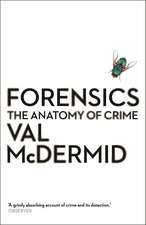The Forensic Anthropology Laboratory
Editat de Michael W. Warren, Heather A. Walsh-Haney, Laurel Freasen Limba Engleză Hardback – 9 mai 2008
Drawing from a wide range of sources, the book begins with detailed descriptions of how body donations are received and processed. It includes extraordinary photos documenting the steps taken to ensure that each body part is tracked from the moment it is received through the decomposition and skeletonization processes. Dr. David Hunt, of the Smithsonian Institution, discusses destructive analysis, diagnostic imaging, casting, and all types of anthroposcopic and anthropometric data collection methods.
The book also compares the duties of full-time forensic anthropologists in a medical examiner’s office with their academic counterparts, discussing staffing, physical plant concerns, field recovery procedures, and laboratory processing. It stresses the variety of required skills, including fingerprinting and other trace evidence procedures, and highlights casework examples from FACES, illustrating the technology used to establish identifications through facial reconstruction, photographic superimposition, and age progression. Using examples from the World Trade Center, Hurricane Katrina, and the Asian Tsunami disasters, the book examines the roles of forensic anthropologists and pathologists as mass fatality responders. It discusses practical issues and explains how and where the mobile disaster morgue can be used, including morgue floor plans and equipment.
A one-of-a-kind survey of a variety of forensic anthropology laboratories, the editors provide an insider’s view of functioning laboratories as reported by some of the most respected and prolific anthropologists in clinical, research, and academic settings.
Preț: 1114.30 lei
Preț vechi: 1358.90 lei
-18% Nou
Puncte Express: 1671
Preț estimativ în valută:
213.21€ • 223.81$ • 176.98£
213.21€ • 223.81$ • 176.98£
Carte tipărită la comandă
Livrare economică 10-24 aprilie
Preluare comenzi: 021 569.72.76
Specificații
ISBN-13: 9780849323201
ISBN-10: 0849323207
Pagini: 238
Ilustrații: 10 b/w images, 5 tables and 80 halftones
Dimensiuni: 156 x 234 x 17 mm
Greutate: 0.6 kg
Ediția:1
Editura: Taylor & Francis
Colecția CRC Press
Locul publicării:Oxford, United Kingdom
ISBN-10: 0849323207
Pagini: 238
Ilustrații: 10 b/w images, 5 tables and 80 halftones
Dimensiuni: 156 x 234 x 17 mm
Greutate: 0.6 kg
Ediția:1
Editura: Taylor & Francis
Colecția CRC Press
Locul publicării:Oxford, United Kingdom
Public țintă
Academic, Professional, and Professional Practice & DevelopmentCuprins
Introduction. The Anthropology Research Facility, University of Tennessee. The Forensic Anthropology Laboratory in a Medical Examiner Setting. Joint POW/MIA Accounting Command’s Central Identification Laboratory. The University of Indianapolis Archeology & Forensics Laboratory. The Mass Fatality Incident Morgue: A Laboratory for Disaster Victim Identification. The Repatriation Osteology Laboratory at the Smithsonian Institution. History and Collections of the Division of Physical Anthropology, Smithsonian Institution. The LSU Forensic Anthropology and Computer Enhancement Services Laboratory. The Working Forensic Anthropology Laboratory.
Notă biografică
Michael W. Warren, Heather A. Walsh-Haney, Laurel Freas
Descriere
While other books cover general topics and various subsets of forensic anthropology, this one-of-a-kind reference compiles the best practices in policies, procedures, and protocols of different laboratories around the world. It brings together experts in every aspect of forensic anthropology to consider physical plant demands, equipment needs, staffing, ethical issues, and the process of certification with the American Society of Crime Laboratory Directors. With examples of implementation, the text also discusses proven methods in skeletal preparation, laboratory flow, and specimen curation including the processing of logs. Sample forms are also provided.














